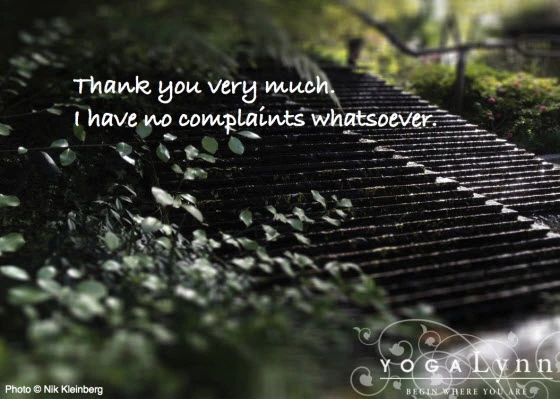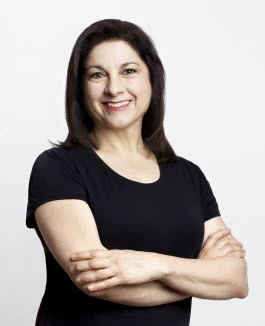Thank You Very Much: The Art of Reframing in Yoga

Have you heard of Sono, the revered Zen master and healer who is said to have lived some 150+ years ago? Legend has it that people traveled from far and wide, seeking this wise woman’s help in relieving their suffering. They would place at her feet issues of health, sorrow and grief, financial troubles, failed relationships, you name it. Her advice to each person was the same. At least twice daily they were to repeat this affirmation:
“Thank you very much. I have no complaints whatsoever.”
It probably won’t surprise you to hear that Sono’s prescription surprised some, puzzled others. More than a few departed feeling cheated and angry to have wasted their time on someone who obviously did not understand real-life problems.
How could she seriously suggest expressing gratitude while things were so amiss?
Of course, the story goes on to reveal that those who took Sono’s advice to heart–even the skeptics–achieved transformative results. Many described deliverance from their suffering–not from the conditions that persisted in their lives mind you, just the degree to which they suffered. Like most profound practices, the brilliance of this one lies in its simplicity.
Pratipaksha Bhavana: Cognitive Reframing
What Sono offered was a one-step course on the art of what psychologists today would call Cognitive Reframing, that is the process of consciously choosing to view a situation from a different perspective to gain insight and understanding. In yoga, the term we use is pratipaksha bhavana.
Reframing works in either direction, so that how we view a difficult situation determines its overall effect on our lives. If we choose to view an event or situations through a lens of hopelessness and pessimism, we will increase our suffering and be more likely to find reasons to be unhappy.
But Sono was smart because words–especially words used in mantra–have transformative power. That simple phrase focused on gratitude helped her seekers to find reasons to be content and happy, despite  hardships.
hardships.
The phrase itself is a reflection that sometimes letting go of the “story” is all we can realistically do. But it’s not a small thing.
Adding a few mindful moments of gratitude to our practice–either on or off-the-mat–can help us connect to the unchanging presence that lies beneath the events and circumstances of our daily lives. It enables us to view current conditions as temporary, illusory and almost always less important than we think in the heat of the moment. And it can remind us of many blessings big and small we may otherwise take for granted.
Rather than living with regret over the past, or a wish-it-were-different-and-waiting-for-change kind of present, accepting what is with gratitude is empowering. It suggests the possibility of contentment and a deep joy that is unrelated to job, bank account, status, or any of the other trappings of daily life.
When we let go of external markers, we become empowered to look for the sweetness of the small miracles that visit us daily.
I realize that this may smack of new-agey happy talk. Does it really benefit us to focus on what’s good in the world rather than the myriad of things there are to complain about? Studies conducted by Dr. Martin Seligman and his team at the University of Pennsylvania in the emergent field of Positive Psychology, say yes. It turns out that people who find joy in their lives live longer.
I don’t know whether Sono was a real person or a fictitious figure created to illustrate a principle. I’m not sure it even matters, because the principle is sound. Modern-day Zen Master Thich Nhat Hanh reminds us often that the seeds we cultivate, feed, and water are the ones that grow.
In difficult times, it’s nice to remember that no matter how bleak things look right now, the potential exists for hope, wonder, curiosity, and connectedness. Even on our worst day, there are usually far more things going right than going wrong, if only we open our eyes and hearts to see them.
There is always a reason to be thankful — Thank you very much!
Turn Your Viewpoint Upside Down: A Yoga Practice for a Fresh Perspective from YogaUOnline and Olga Kabel.
Or Study with Dr. Ginger Garner and YogaUOnline – The Three Diaphragms of the Body in Yoga: Core Foundations for Health and Wellbeing.

Lynn Crimando, MA serves as the teaching mentor for YogaUOnline’s Wellness Educator Program. She is a yoga teacher, C-IAYT Yoga Therapist, board-certified Health and Wellness Coach, and a Buteyko Practitioner. She has a private practice in New York City and teaches classes throughout the city on behalf of Health Advocates for Older People. In addition, Lynn is on the faculty of the IAYT-approved Yoga Polarity Therapist Training in Malverne, New York. To learn more about Lynn, visit her website: yogalynn.com.



